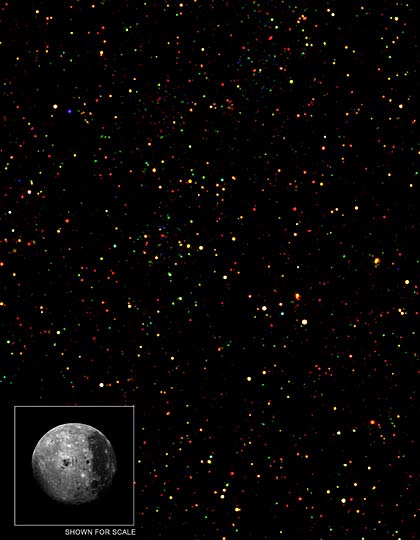Discovery Makes Black Holes More Puzzling

A new survey revealing more than a thousand supermassive black holes in one region of the sky calls into question a popular model of how the gravity monsters behave.
- Multimedia: All About Black Holes
Black holes can't be seen, but astronomers identify them by their gravitational effects on surrounding material and by noting emissions of X-rays and other radiation from their maws.
Typically, a black hole is surrounded by a doughnut-shaped region, or torus, of gas. The view of the black hole's immediate surroundings is blocked by this torus by different amounts, depending on the orientation whether we're looking through it edge-on or looking down on the setup from above, the thinking goes.
If true, then astronomers should find a range of absorption of the radiation from the nuclei of black holes-from nuclei that are heavily obscured and barely detectable to those that are not obscured at all, along with everything in between.
"Instead of finding a whole range, we found nearly all of the black holes are either naked or covered by a dense veil of gas," said Ryan Hickox of the Harvard-Smithsonian Center for Astrophysics. "Very few are in between, which makes us question how well we know the environment around these black holes."
The objects found are called active galactic nuclei, or AGNs. They are very bright objects shrouded in dust and gas and thought to be developing galaxies anchored by black holes.
This study found more than 600 obscured and 700 unobscured AGNs, located between about 6 billion to 11 billion light years from Earth. A light-year is the distance light travels in a year, about 6 trillion miles (10 trillion kilometers). So these objects are seen as they existed billions of years ago. The universe is about 13.7 billion years old.
Get the Space.com Newsletter
Breaking space news, the latest updates on rocket launches, skywatching events and more!
The black holes were detected [image] by combining data from NASA's Chandra X-ray Observatory, the Spitzer Space Telescope and ground-based optical telescopes.
- The Strangest Things in Space
- Getting a Grip on Black Holes
- Multimedia: All About Black Holes
- The Tricky Task of Detecting Black Holes
- All About Black Holes
Join our Space Forums to keep talking space on the latest missions, night sky and more! And if you have a news tip, correction or comment, let us know at: community@space.com.

Space.com is the premier source of space exploration, innovation and astronomy news, chronicling (and celebrating) humanity's ongoing expansion across the final frontier. Originally founded in 1999, Space.com is, and always has been, the passion of writers and editors who are space fans and also trained journalists. Our current news team consists of Editor-in-Chief Tariq Malik; Editor Hanneke Weitering, Senior Space Writer Mike Wall; Senior Writer Meghan Bartels; Senior Writer Chelsea Gohd, Senior Writer Tereza Pultarova and Staff Writer Alexander Cox, focusing on e-commerce. Senior Producer Steve Spaleta oversees our space videos, with Diana Whitcroft as our Social Media Editor.









